24 Years of Research
24 years of interdisciplinary development of physical Formosan termite barriers
The International Code Council (ICC) AC 380 standard for Termite Physical Barrier Systems
Development of TERM physical termite barriers began in November 1999. However, this account starts with the 2014 publication of the ICC AC 380 Acceptance Criteria for Termite Physical Barrier System
Development of TERM physical termite barriers began in November 1999. However, this account starts with the 2014 publication of the ICC AC 380 Acceptance Criteria for Termite Physical Barrier System
The testing required for AC 380 is one of the most expensive and time consuming that we have seen, because AC 380 follows the requirements used by state pest control regulators for termite treatments. These include five years of controlled field trials at multiple sites infested with Formosan termites, with annual monitoring and detailed recordkeeping.
The testing required for AC 380 is one of the most expensive and time consuming that we have seen, because AC 380 follows the requirements used by state pest control regulators for termite treatments. These include five years of controlled field trials at multiple sites infested with Formosan termites, with annual monitoring and detailed recordkeeping.
We strongly recommend that you specify only termite physical barriers meeting AC 380 criteria. There are products claiming to be termite physical barriers, which have no testing, lab testing, or field testing which failed within a year of installation.
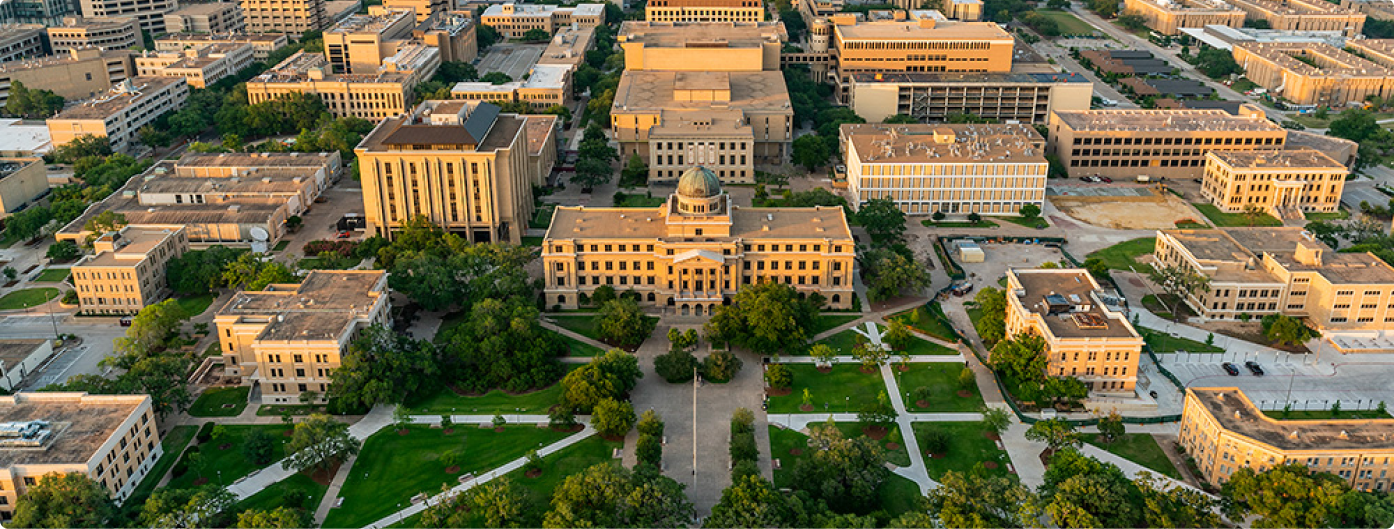
Development began with a 1999 meeting
Polyguard has manufactured structural waterproofing since 1970. Customers in the mid 1990’s included members of the Insulated Concrete Forms Association (ICFA). When we attended ICFA’s late 1999 meeting, the main discussion topic was the decision of Southern Building Code officials to prohibit below grade ICF construction unless the ICF was protected by an approved termite barrier. This was done because it had been found that termites were building colonies inside the foam of ICF foundations. Termites preferred to nest in ICF, because they were isolated from predators, temperatures were warm, and their preferred food (soft and easily chewed Southern Pine} was just above.
The ICFA had invited Dr. Roger Gold, Endowed Chair of Urban Entomology at Texas A&M, to discuss termites and possibilities for development of physical termite barriers. During the Q&A time, Dr. Gold mentioned that his department could run a 30-day screening test of termite resistance. This started a relationship which still goes on today. Weeks later we visited Texas A&M and agreed to run Dr. Gold’s 30-day screening test on a Polyguard membrane with an upgraded formulation. The screening test in spring of 2000 gave encouraging results.
It was in these early months that Dr. Gold told us about the Formosan termite threat. Formosans arrived at the Gulf Coast, and the earliest infestations occurred in Texas and Louisiana. Thus, the first test was run against both Genus Reticulitermes (the dominant mainland subterranean termite) and Genus Coptotermes (the new invasive termite). Since then, most subterranean termite tests have evaluated against Formosan termites.
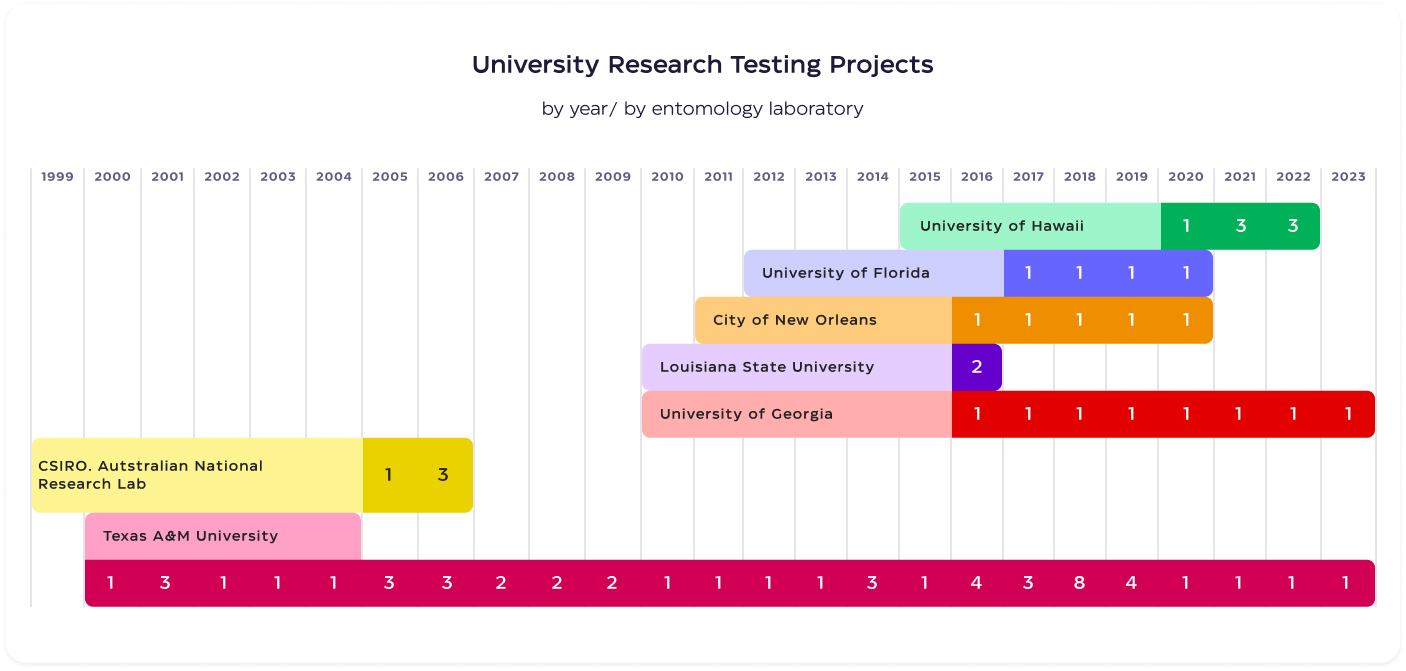
Highlights of barrier development
Below is a graphic of places where testing or research was conducted on TERM barriers. The numbers show how many projects were conducted during that year.
It has been a fascinating couple of decades. We started with a goal of upgrading Polyguard building envelope products to exclude termites. That goal has been mostly met. But now our scope has been expanded to exclusion of all pests, all around the structure, using three types of barriers.
During a pest control conference several years ago, a well-respected school Integrated Pest Management (IPM) administrator announced; “I wish I could get my hands on some of those architects.” That line drew a good laugh from the audience, who were mostly people with a lot of experience crawling around and underneath structures searching for, remediating pest entry points, and applying pesticides.
There are many simple things which can be done to exclude pests from structures. Now that Formosan termites have entered the picture, there should be urgency about exclusion.
Over the years our collaboration with the universities and other institutions shown above has led to many tests of our barriers. Here is a link to most of them Link to Institutional testing. We have not listed every test. Excluded are tests in progress, tests of future product concepts, and tests of alternative installation methods. These are not included because we wish to keep potential future products confidential, or (with failed tests) we do not want to tell competitors what not to do. If you are a researcher, regulator, or specifier, we will be happy to provide a copy of specific tests.
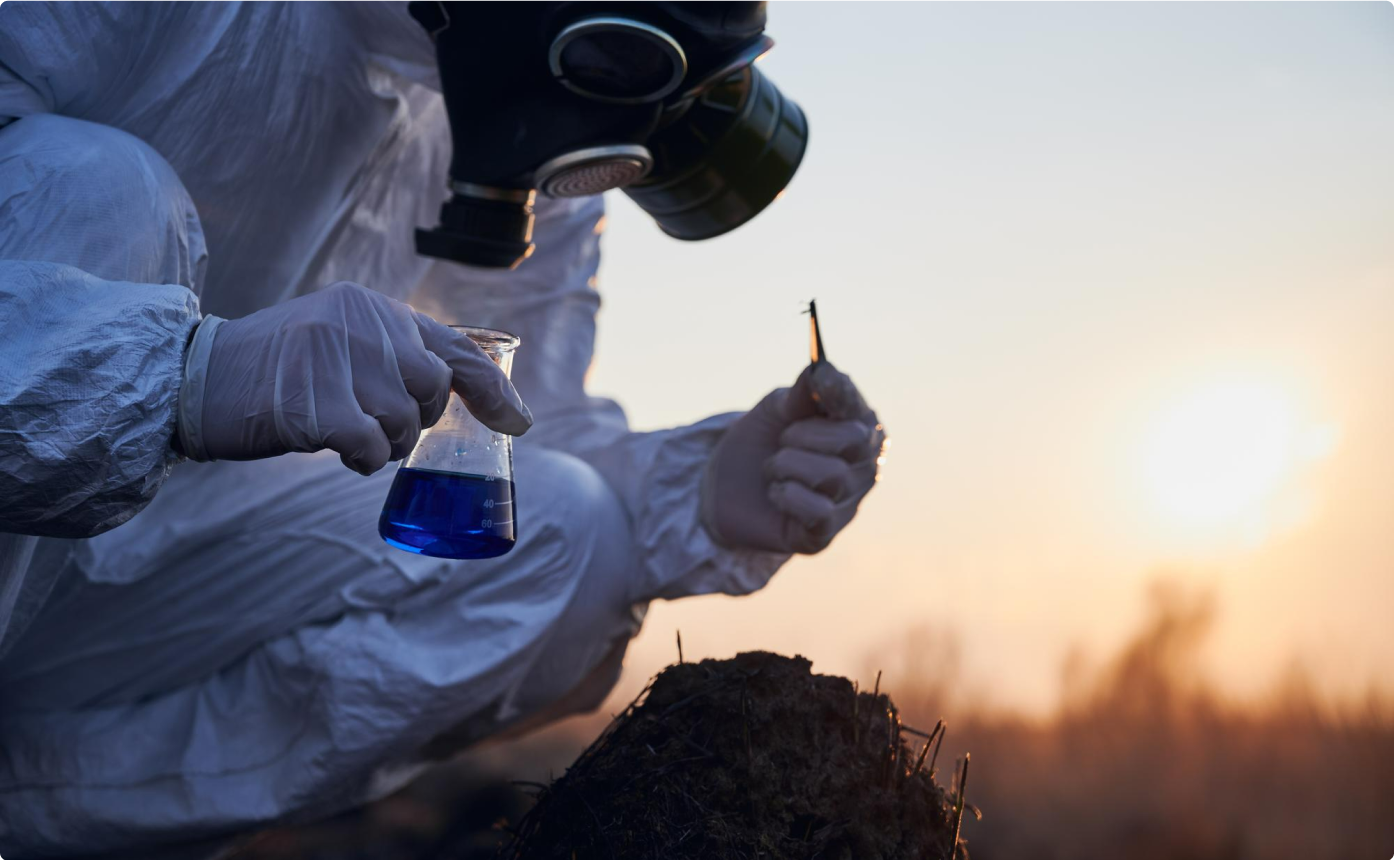
Resistance to pesticides
In 2003 we tested the new waterproofing/termite barrier to see if it would resist penetration by termiticide chemicals. We did this because todays construction is often built on land historically used for farming, which may have a residual of highly poisonous termiticides which can remain active in the soil for > 50 years. Over the years some farmland became a “pesticide brownfield.”
After WWII ended, both the U.S. and Germany, knowing that these chemicals were effective pesticides, introduced pesticides to the farm and home market. Today the largest pesticide companies trace their origin to this work.
From 1948 to 1988 Chlordane was widely used. Chlordane, classed by the EPA as a probable carcinogen, is resistant to chemical breakdown. Estimates of its life in the soil range as high as 50 years.
Since much of today’s construction takes place on land which was formerly farmland, there is still a possibility that Chlordane and successor pesticides Permethrin and Fipronil, could remain active in the soil of the construction site. This is the reason behind our 2003 test of the Repellency of Polyguard Underseal membrane.
Polyguard membrane was tested for repellency of Chlordane, Permethrin, and Fipronil at two contamination levels. There was no penetration through the Polyguard material with any pesticides at either contamination level.
University of Florida / City of New Orleans Termite Lab / Polyguard field trial
We were introduced to Dr. Phil Koehler, University of Florida Endowed Professor of Structural Pest Control, and to the New Orleans Mosquito, Termite, and Rodent Control Board around 2015 by Dr. Mel Kyle, retired Research Director for Bayer Chemical. Several tests were performed by the Termite Control Board which were encouraging, resulting in discussions about a joint field trial between UF, the City of New Orleans, and Polyguard.
The field trial was large, consisting of 50 miniature homes. We called them “gnome homes.”
Testing Polyguard TERM barriers on 50 Mini Homes
Source: Polyguard Field Trial in collaboration with University of Florida and City of New Orleans Termite Lab

- 20 were protected by Polyguard TERM membrane, TERM sealant, and TERM wire screen.
- 20 by Polyguard Particle Barrier, used as a perimeter treatment around the foundation.
- 10 were untreated controls with no chemical or physical barrier treatment.
- Additionally, untreated wood stakes were spread throughout the test plot.
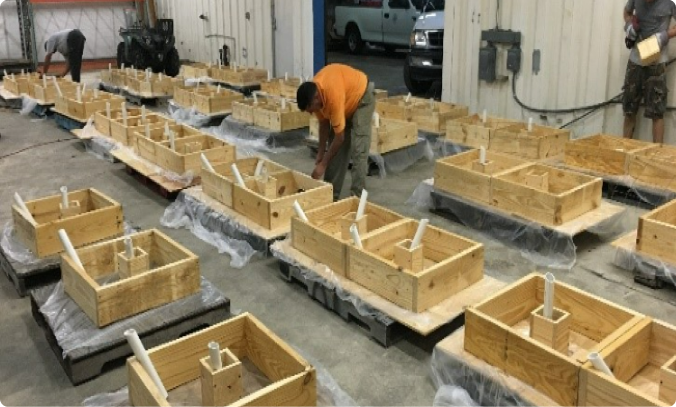
- 6” thick concrete “slabs” were necessary to evaluate the 8 – 16 sieve size particle barrier, which is installed in a 5” deep wedge against the foundation wall.
- The forms and concrete had to be poured in a warehouse because the field conditions were extremely wet and raining.
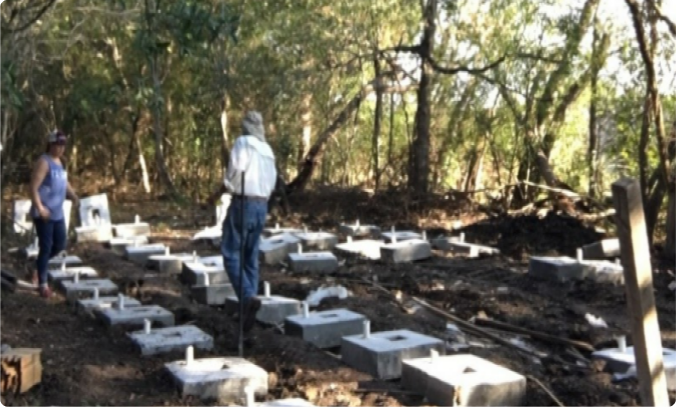
- The pre-poured slabs were moved out into the field site next to a New Orleans levee and loose wood placed underneath the slabs during installation. This was done to increase termite pressure in the test area.
The levee where the “gnome homes” were installed had heavy infestations of Formosan termites. The “slabs” each weighed about 200 lbs.
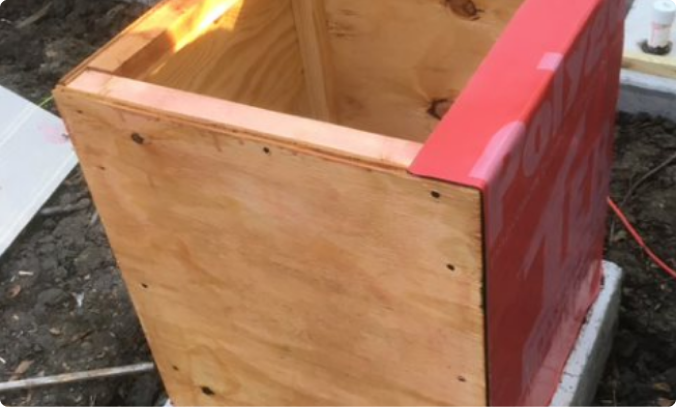
- Structures with Polyguard TERM Membrane are shown to the right during construction.
- Bath traps were protected by Micromesh stainless steel screen with 0.02” openings.
- Slab penetrations were protected with a bead of Termite Sealant (not installed in this photo).
- Slab penetrations were protected with a bead of Termite Sealant (not installed in this photo).
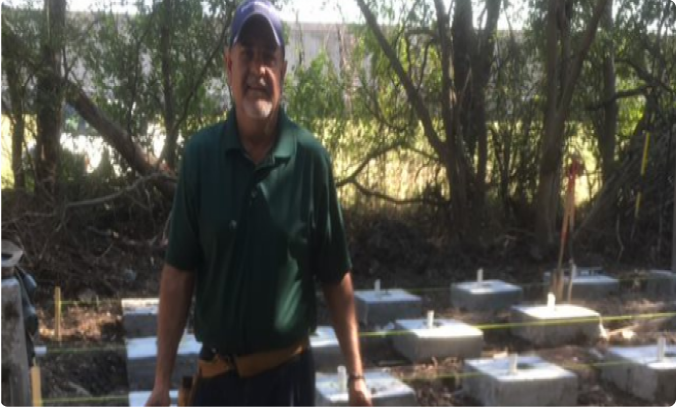
- Each gnome home was covered by a roof fabricated from steel plate.
- Underneath the roof a cover plate with a removable plexiglass cover
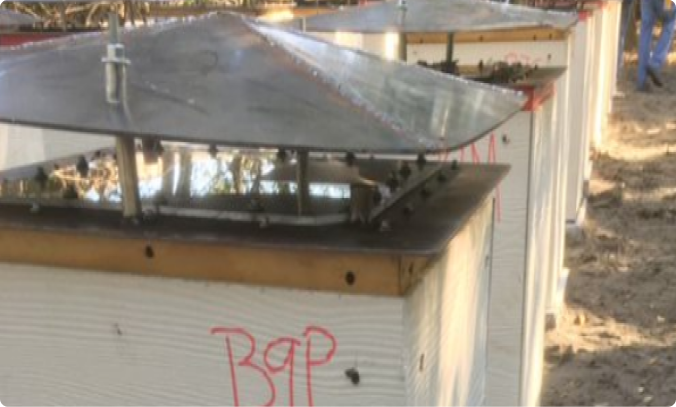
This photo shows one of the test homes which was protected only by a perimeter treatment of 8 - 16 sieve size particle barrier.
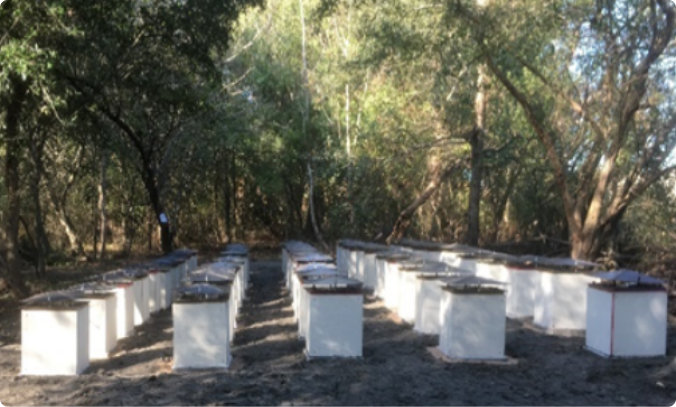
- The completed test plot.
Evaluations were scheduled for every three months for the first year, and every six months for the remainder of the trial, which was scheduled to be five years.
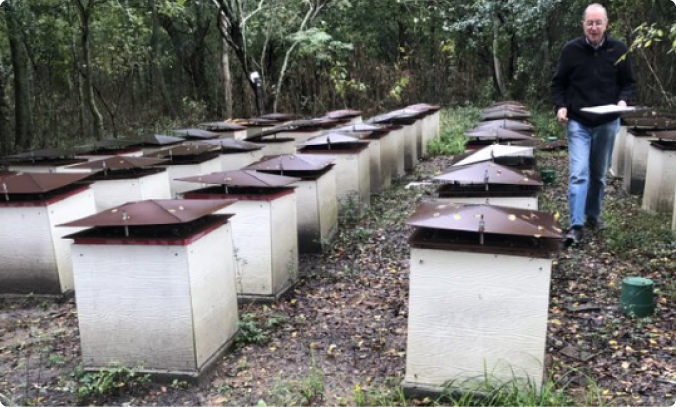
- Photo documenting gnome home test plot at two year inspection with Dr. Phil Koehler.
